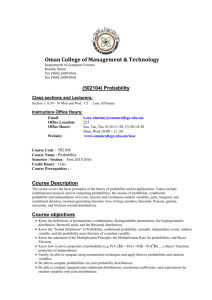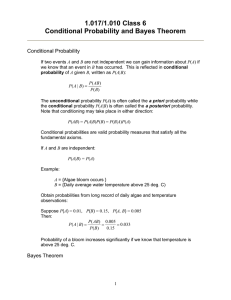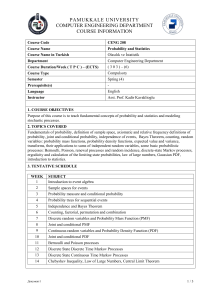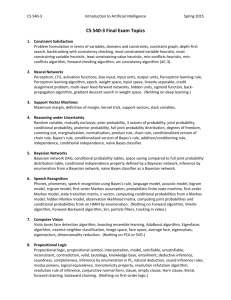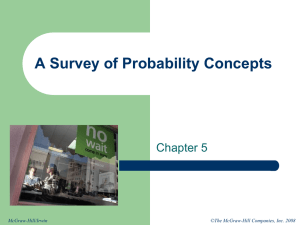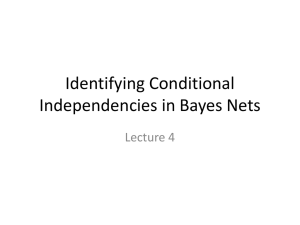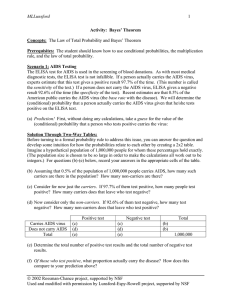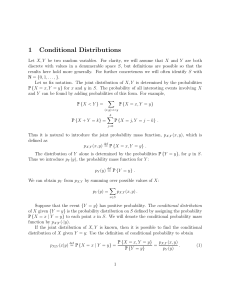Conditional Probability, Bayes Theorem, Independence and
advertisement
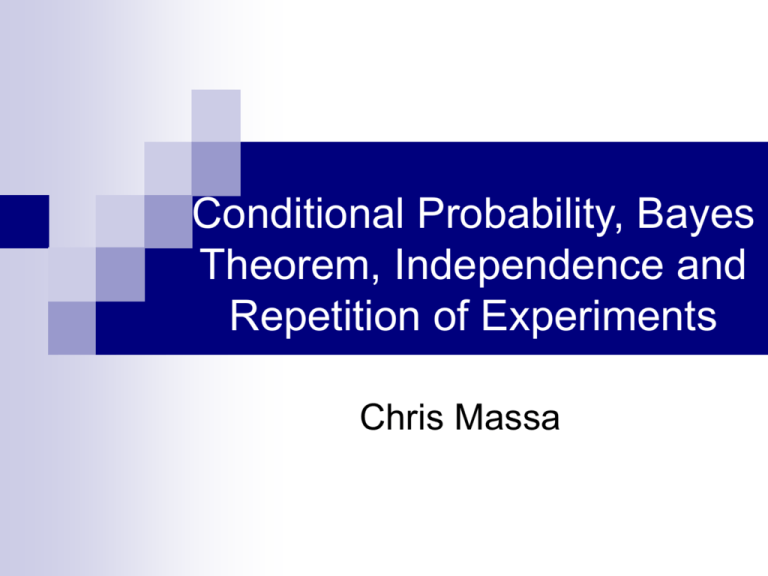
Conditional Probability, Bayes
Theorem, Independence and
Repetition of Experiments
Chris Massa
Conditional Probability
“Chance” of an event given that something is true
Notation:
pa b
Probability
of event a, given b is true
Applications:
Diagnosis
of medical conditions (Sensitivity/Specificity)
Data Analysis and model comparison
Markov Processes
Conditional Probability Example
Diagnosis using a clinical test
Sample Space = all patients tested
Event A:
Subject has disease
Event B: Test is positive
Interpret:
p A B Probability patient has disease and positive test (correct!)
p A B ' Probability patient has disease BUT negative test (false negative)
p A' B Probability patient has no disease BUT positive test (false positive)
p A B Probability patient has disease given a positive test
p A B ' Probability patient has disease given a negative test
Conditional Probability Example
If only data we have is B or not B, what can we
say about A being true?
Not
as simple as positive = disease, negative = healthy
Test is not Infallible!
Probability depends on union of A and B
Must Examine independence
p A B
pA B
p B
p A B ' p A B '
p A B '
p B '
1 p B
Does
p(A) depend on p(B)?
Does p(B) depend on p(A)?
Events are dependant
Law of Total Probability & Bayes Rule
Take events Ai for I = 1 to k to be:
exclusive:
for all i,j
Ai A j 0
Exhaustive:
A1 Ak S
Mutually
For any event B on S
p( B) p( B A1 ) p( A1 ) p( B Ak ) p( Ak )
k
p( B) p( B Ai ) p( Ai )
i 1
Bayes theorem follows
p( A j B)
p( A j B)
p( B)
p( B A j ) p( A)
k
p( B A ) p( A )
i 1
i
i
Return to Testing Example
Bayes’ theorem allows inference on A, given the
test result, using knowledge of the test’s accuracy
and population qualities
is test’s sensitivity: TP/ (TP+FN)
p(B|A’) is test’s false positive rate: TP/ (TP+FN)
p(A) is occurrence of disease
p(B|A)
p( A B)
p( A B)
p( B)
p( B A) p( A)
k
p( B A ) p( A )
i 1
i
i
k
p( B A ) p( A ) p( B A) p( A) p( B A') p( A' )
i 1
i
i
p( B A) p( A) p( B A')(1 p( A))
Likelihood Ratios
Similar comparison can be done to find the
probability that the person does not have a
disease based on the test results
p( B A' ) p( A' )
p( A' B)
p( A' B)
k
p( B)
p( B Ai ) p( Ai )
i 1
Similarly, since A and A’ are independent
p( A' B) 1 p( A B)
Here, the likelihood ratio is the ratio of the
probabilities of the test being correct, to the test
being wrong.
Numerical Example
Only 1 in 1000 people have rare disease A
TP
= .99
FP=.02
If one randomly tested individual is positive, what is the
probability they have the disease
Label events:
A=
has disease
Ao = no disease
B = Positive test result
B+
Examine probabilities
p(A)
= .001
p(Ao)= .999
p(B|A) = .99
p(B|Ao)= .02
A
Ao
BB+
B-
Numerical Example
Examine probabilities
p(A)
= .001
p(Ao)= .999
p(B|A) = .99
p(B|Ao)= .02
p(A ∩ B) = .00099
p(Ao ∩ B) = .01998
Independence
Do A and B depend on one another?
Yes!
B more likely to be true if A.
A should be more likely if B.
If Independent
p A B p A p B
pA B p A pB A pB
If Dependent
p A B p A p B
p A B p A p B p A B
p A B p B A p A
Repetition of Independent Trials
p A B p A p B
pA B p A pB A pB
Recall
If independent trials are repeated n times,
formulae may exist to simplify calculations
Examples include
Binomial
Multinomial
Geometric
Binomial Probability Law
Requires:
n
trials each with binary outcome (0 or 1, T or F)
Independent trials, with constant probability, p.
PDF of Binomial random variable X~ b(x;n,p)
Where
CDF:
x = number of 1s (or Ts)
n x
n x
p (1 p )
x 0,1,2, , n
b( x; n, p ) x
0
otherwise
x
P( X x) B( x; n, p) b( y; n, p) x 0,1,2,, n
y 0
E( X ) np V ( X ) np(1 p) x np(1 p)
Hypergeometric Probability Law
Requires:
Fixed,
finite sample size (N)
Each item has binary value (0 or 1, T or F), with M
positive values in the population
A sample of size n is taken without replacement
PDF of hypergeometric R.V. X~ h(x;n,M,N)
M N M
x n x
h( x; n, M , N )
N
n
max( 0, n N M ) x min( n, M )
M
E( X ) n
N
M
N n
V (X )
n
N
N 1
M
1
N
Repetition of Dependent Events
Relies on conditional probability calculations.
If a sequence of outcomes is {A,B,C}
P A B C PC | A B P A B
PC | A B P A | B P A
This is the basis of Markov Chains
e.g. Two urn problem
Two
urns (0 and 1) contain balls labeled 0 or 1.
Flip a coin to decide which jar to chose a ball from
Pick a ball from the jar indicated by the ball chosen
Can determine probability of the path taken using
conditional probability arguments
Markov Chains
Given a sequence of n outcomes {a0, a1,..., an}
Where
P(ax) depends only on ax-1
Pa0 , a1 ,, an Pan | an`1 Pan1 | an2 Pa1 | a0 Pa0
Probability of the sequence is given by the
product of the probability of the first event with
the probabilities of all subsequent occurrences
Markov chains have been explored through
simulation (Markov Chain Monte Carlo – MCMC)


